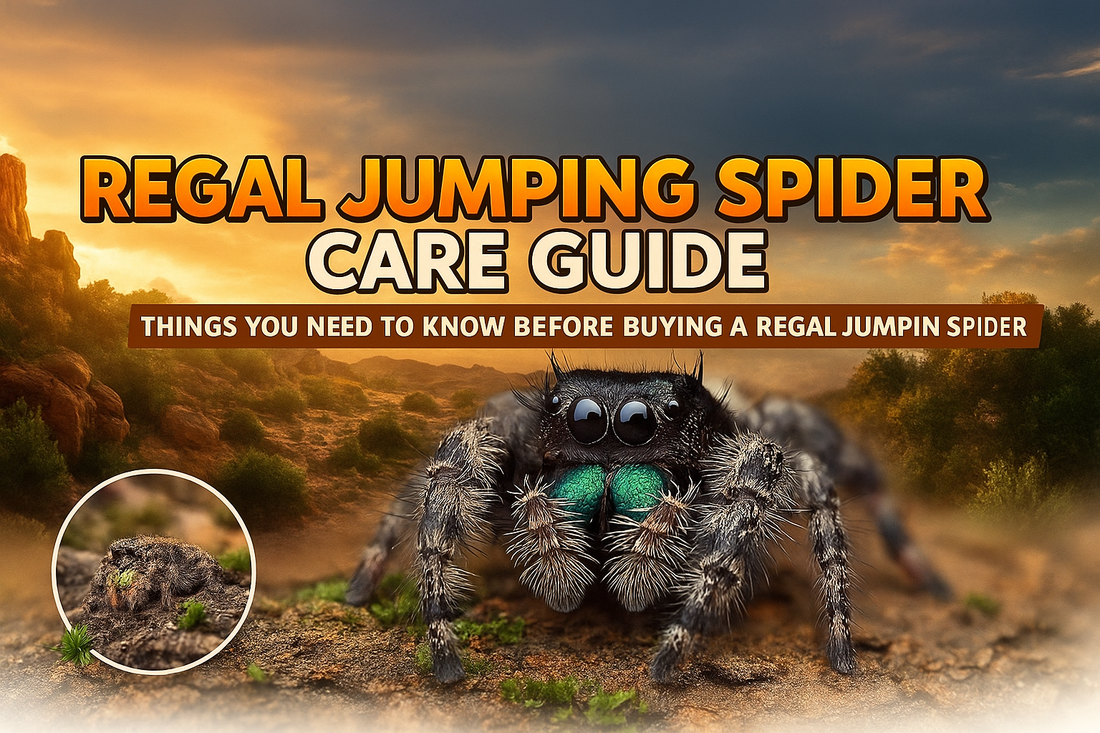
Regal Jumping Spider Care Guide
Share
Natural Habitat
Regal jumping spiders are found in the southeastern United States, especially Florida. They thrive in warm, sunny environments where they hunt during the day and build silk retreats at night.

Beginner or Advanced: Beginner
Regal jumping spiders are great for beginners. They are hardy, curious, and display engaging behaviors that make them fun to watch.
Size & Lifespan
- Size: 10–22 mm (females are larger than males)
- Lifespan: 1–2 years (females usually live longer)
Sexing
Regal Jumping Spiders (Phidippus regius) can be sexed visually, especially once they’re juveniles or adults. Here’s how to tell males from females:
1. Size and Build
- Females: Larger overall, with a more robust, rounded abdomen.
- Males: Smaller, slimmer body, especially with a narrower abdomen.
2. Chelicerae (fang bases)
- Males: Often more brightly colored (iridescent green/blue) and more prominent.
- Females: Still iridescent, but the chelicerae tend to look slightly less exaggerated compared to males.

3. Coloration and Patterns
- Females: Usually show clear black-and-white or orange patterning on the top of the abdomen. They often look more boldly patterned.
- Males: Generally darker overall, sometimes almost solid black, with less distinct patterning.
4. Pedipalps (the “boxing glove” looking appendages by the mouth)
- Males: Enlarged, bulbous tips (these are their reproductive organs). This is the most reliable indicator.
- Females: Pedipalps are thinner and not swollen at the tips.

5. Behavior (secondary clue)
- Males: Tend to be more active, wander more, and may perform courtship dances when near a female.
- Females: More sedentary, often guarding or staying near a nest.
The pedipalps are the easiest and most accurate way to sex a Regal Jumping Spider once it’s at least juvenile age.
Enclosure Setup
- Enclosure size: At least 5x5x7 inches (vertical space is important since they like to climb)
- Ventilation: Critical — fine mesh or cross-ventilation to prevent mold
- Decor: Branches, cork bark, fake or live plants, and plenty of anchor points for webbing
- Lid: Must be secure — these little guys are escape artists!
Heat & Humidity
- Temperature: 75–82°F ideal (can tolerate room temps, but growth is slower)
- Humidity: 50–65% with good airflow
- Light misting 2–3x per week provides drinking droplets but avoid overwatering
Diet
Regal jumping spiders are insectivores and eat only live prey.
- Staples: Small crickets, fruit flies, mealworm beetles, tiny roaches
- Feeding schedule:
- Spiderlings: 3–4x per week
- Adults: 1–2x per week
- Only offer prey smaller than the spider’s body length
Supplements
They do not need vitamin or calcium supplements — their nutrition comes directly from live prey.
Handling & Temperament
Regal jumping spiders are naturally curious and often tolerate gentle interaction. Many will even hop onto their owner’s hand on their own.
- Never grab them — let them come to you
- Handle close to a table or floor in case they jump
- Avoid over-handling, as stress shortens their lifespan
